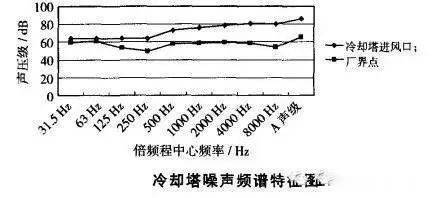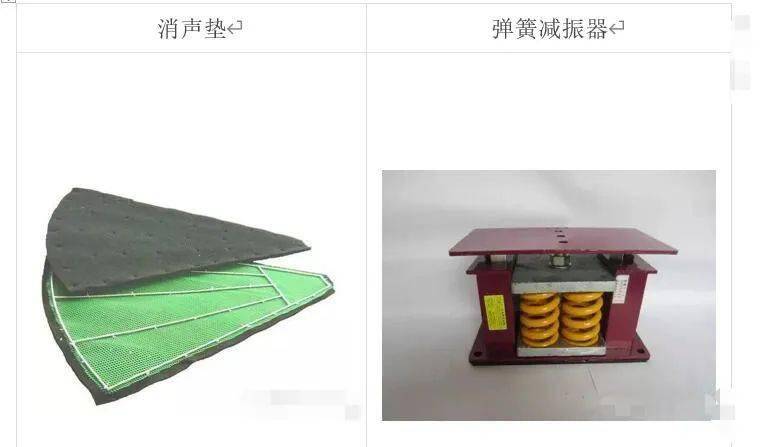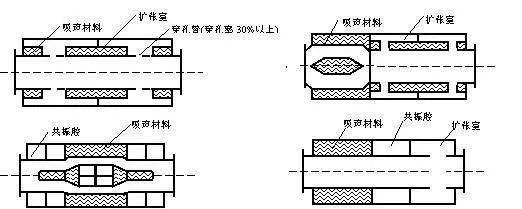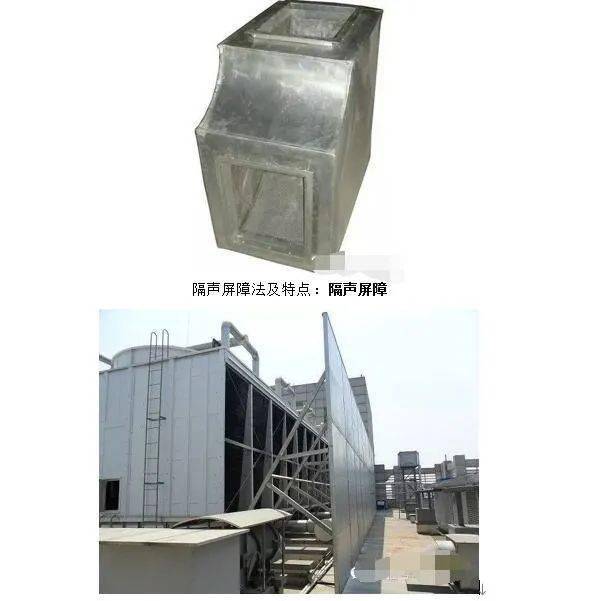Cooling tower noise reduction treatment method
Author:Trlon Views: Time:2020-11-17
Evaluation index of cooling tower noise
Current status of cooling tower noise control
If the company produces cooling towers in accordance with the maximum limits of GB/T7190.1-1997 and GB/T7190.2-1997, all products cannot meet the national standard GB3096-2008. For areas below Class II, the noise at night is ≤45~50dB(A) It is required that only a few low-tonnage and ultra-low noise cooling towers can meet the requirements of night noise standards in a small number of areas. The current noise reduction measures for cooling towers are not effective. For example, sound barriers are incapable of diffraction of low-frequency waves, sound insulation hoods will hinder airflow, resulting in poor heat and moisture exchange, and poor sound absorption for broadband noise. Noise control is getting more and more attention. Therefore, the residents around the cooling tower and the government's environmental protection department require cooling tower users to control the noise pollution generated by the cooling tower in accordance with the national environmental noise standard GB3096-2008.
Cooling tower noise source The cooling tower noise source is mainly composed of the following four parts:
1) The noise of fan inlet and exhaust;
UL0Cooling tower noise reduction treatment manufacturer2) Water spray noise;
UL0Cooling tower noise reduction treatment manufacturer3) Noise from fan reducer and motor;
UL0Cooling tower noise reduction treatment manufacturer4) Noise from cooling tower water pumps, piping and valves.
UL0Cooling tower noise reduction treatment manufacturerSound source attributes: the noise source is the huge circular water surface under the falling water area, which is the steady-state water noise generated by the large area continuous liquid impact of the cooling falling water in the tower on the pool water; it is in addition to mechanical noise, aerodynamic noise, and electromagnetic noise A special kind of noise.
UL0Cooling tower noise reduction treatment manufacturerSound source characteristics Sound source sound level: about 80dB (A). Frequency spectrum: The audio distribution is a peak-shaped curve with high frequency (1000-16000 Hz) and intermediate frequency (500-1000Hz) components; the peak value is around 4000Hz. Sound speed: c=340m/s. Wavelength: λ=c/f; 1.36m (250 Hz) ~ 0.02 m (1000 Hz), mainly 0.085m (4000 Hz). The two main noise sources are fan noise: sound wavelength, strong penetrating ability, insignificant sound attenuation, and difficult management.
UL0Cooling tower noise reduction treatment manufacturerThe air produces turbulence and pressure disturbances excited by friction in the draft tube on the top of the cooling tower, and produces noise. At the same time, the action of the blades and the air produces vibration and radiates noise. The aerodynamic noise of the fan is the main sound source. The two most important sources of noise are falling water noise: mainly high frequency, which is easier to manage. The circulating water of the cooling tower falls freely through the packing layer to the sink, resulting in impact noise. The intensity is proportional to the square of the falling water speed. The measurement result shows that the A-level noise of the falling water reaches 70dB, which is one of the noise sources that the cooling tower needs to control.

The attenuation law of the distance of the sound wave The attenuation characteristics of the falling water noise with the distance are in line with the law that the hemispherical wave attenuates with the expansion of the energy distribution during the propagation process. The distance attenuation law of the "point sound source" is the sound energy attenuation for every doubling of the distance 6dB. The formula is: L 1 -L 2 =20 lg (r 2 /r 1) where: L 1, L 2 —— the sound level value of two measuring points from the near and far edge of the sound source, dB; r 2 /r 1 —— The ratio of the distance between the far and near measuring points to the edge of the sound source. When r 2 /r 1 =2, lg (r 2 /r 1) = 0.3010, so L 1 -L 2 = 20 lg (r 2 / r 1) = 6 dB. The starting position of the cooling tower as the “point sound source” According to the measured data of the existing distance attenuation, the analysis of the law of each starting position d (the air inlet is the edge of the sound source) shows that the cooling tower is regarded as the starting point of the “point sound source”. The starting position d can be estimated by the following formula: d=a1/2/4 where: a——the area of the cooling tower, m 2.UL0Cooling tower noise reduction treatment manufacturer
Taking a 2000 m 2 cooling tower with a common range in my country as an example, the starting position d of the "point sound source" (starting from the bottom edge of the air inlet) is 11.18 m. It can be seen that the noise measurement points set 12 m away from the tower (take the bottom edge of the air inlet as the starting point) basically can regard all cooling towers as "point sound sources" such as attenuation by the distance of "point sound sources" The rule is that for every doubling of the distance, the sound energy attenuation is 6dB, the sound level at 50m should be 65.7 and 71.ldB(A) respectively; the sound level at 100m should be 59.7 and 65.ldB(A) respectively; The sound level at m should be 53.7 and 59.ldB (A), respectively, and the sound level at 220 m should be 52.9 and 58.3 dB(A) calculated by formula. This is the rough assessment of the noise impact range (strength), which includes the various large and small tower types that are currently common.UL0Cooling tower noise reduction treatment manufacturer
With this method, we can evaluate the sound levels of various tower types (single towers) based on the sound level measured at the remote measurement point at a distance of 10-25 m (the starting position of the "point sound source" corresponding to the size of each tower and its tower type). Noise influence range (strength). But this is only a simple and rough evaluation method under ideal conditions.
Principle of cooling tower noise reduction project:
When sound waves encounter obstacles in the propagation process, there will be three phenomena of reflection, transmission and diffraction. The sound barrier is to insert a facility between the sound source and the sound receiving point to isolate and absorb the direct sound waves from the sound source to the sound receiving point, so that part of the sound wave is blocked and reflected, and part of the sound wave is absorbed and attenuated and transmitted through the screen (extremely Small) and additional attenuation forms such as the top of the screen to reach the sound point, to reduce the noise impact of the sound point and achieve the purpose of noise reduction.
Low frequency noise control of fan:
The choice of muffler is very important. Generally, the effect of muffler on medium and low frequency noise is not obvious. The effect of resistant muffler is good, but the frequency selectivity is very strong. Therefore, the impedance compound muffler is generally selected. Impedance composite muffler refers to a muffler that properly combines sound absorption and sound reflection. At the same time, it has the characteristics of a resistive muffler to eliminate medium and high frequency noise and a resistive muffler to eliminate low and medium frequency noise, and has a wide-band noise reduction effect.
High-frequency noise control of falling water:
Treatment is relatively easy, but attention should be paid to sound insulation treatment and avoid affecting the performance of heat dissipation. Although mufflers and silencing louvers can greatly reduce noise, they must be designed reasonably, and the heat dissipation performance and power performance must be considered comprehensively. Unreasonable structure will not achieve the purpose of noise reduction. Too much flow resistance will affect the work of the cooling tower and reduce the refrigeration capacity: poor power performance design will also increase resistance and even produce reverberation noise, so comprehensive consideration should be given to the treatment process.
Several common cooling tower noise reduction methods
Sound guide blade method (silencing elbow):UL0Cooling tower noise reduction treatment manufacturerNoise reduction guide vane method and characteristics Install a sound reduction guide vane at the air inlet of the cooling tower, and reduce the influence of the noise of the cooling tower on the outside world through the silencing effect of the noise reduction guide vane, also known as the muffler method. Theory and experiments show that its noise reduction can reach 35dB(A) or even higher; when the noise reduction is 15-20dB(A), it is equivalent to the cost of the sound barrier, and it is the only noise reduction above 20dB(A). Option; compact structure, does not occupy additional space for the building, and basically does not require maintenance.
Silencing guide vane method (silencing elbow):
Noise barriers are generally designed to be greater than the height of the air inlet of the cooling tower from the air inlet of the cooling tower, and the height of the barrier is equal to the distance from the barrier to the air inlet. The noise reduction effect is generally 10-15dB(A). Theoretically, the amount of noise reduction can be about 2OdB(A), but there is a problem of sound wave diffraction. The noise reduction is better in the sound shadow area, and the diffraction area is brighter. The noise reduction effect in the area is poor, so it is difficult to reduce the noise in the affected area by 20dB(A) in actual engineering; it has little impact on ventilation and is relatively simple to maintain; the technical requirements for building sound barriers are not high, but the structural requirements are quite high , And the investment cost doubles as the height increases;
Sound barrier method and characteristics:
The structure of the sound barrier can be divided into two parts: above ground and underground. The above ground is a huge, continuous panel facade (including diagonal braces) with a thickness of about 20 cm to shield sound waves. The top of the sound barrier is a fan-shaped sound absorber or an inwardly inclined shield. Eaves; the underground part is the foundation for load-bearing and anti-overturning (wind load). The noise reduction effect of the sound barrier The diffraction phenomenon of sound waves encountering the barrier will weaken the sound insulation effect of the sound barrier, and the diffraction ability is related to the frequency of the sound wave, so the noise reduction effect of the sound barrier has a very close relationship with the frequency of the sound wave, that is, the wavelength. Big. The sound barrier has a very significant shielding effect on high-frequency waves with short wavelengths that are not easily diffracted, and can form a long sound shadow area behind the barrier; while the shielding effect on low-frequency waves with wavelengths and strong diffraction capabilities is very limited. Of course, it is also possible to increase the barrier to weaken the influence of the diffracted sound wave on the sound point.
UL0Cooling tower noise reduction treatment manufacturerSince the sound barrier has an obvious and effective shielding effect on high-frequency sound waves, and the frequency spectrum of the falling water noise of the cooling tower is mainly in the middle and high frequency components, the use of the sound barrier can achieve a certain noise reduction effect. The noise reduction effect of the sound barrier is best in the local area close to the barrier in the sound shadow area, and the noise reduction level outside the sound shadow area can be as high as 25 db. The noise reduction level outside the sound shadow area will rebound due to the arrival of the intermediate frequency diffraction sound wave. For high frequency waves, the attenuation can generally reach 10-15dB.
UL0Cooling tower noise reduction treatment manufacturerHowever, since the falling water noise of the cooling tower still contains intermediate frequency components, its noise reduction effect will be discounted. For sound points outside the building, in order to achieve a satisfactory noise reduction effect, it should be adjusted by increasing the height of the barrier without affecting the air intake. When installing the sound insulation barrier, the main attention is that the distance between the sound insulation barrier and the air inlet of the cooling tower louver is about 1m to ensure that the air exchange inlet of the cooling tower is not blocked, so that the cooling effect of the cooling tower is better.
UL0Cooling tower noise reduction treatment manufacturerIn order to prevent noise from being diffracted and affecting the acoustic effect of the sound-absorbing deflector, a sound barrier of a certain length can be installed near the sound-absorbing deflector to assist in noise reduction. Falling water silencing method and characteristics: Install falling water energy dissipation and noise reduction materials above the water surface at the bottom of the cooling tower to reduce the noise source from the source. The noise reduction effect is generally 6-10dB(A); the initial investment is small, and it has no effect on ventilation and heat dissipation; the disadvantage is that the noise reduction is less, the components are easily damaged, the maintenance workload is large, and continuous investment is required, and it may also cause condensation The problem of the pipe clogging. "Falling water energy dissipation noise reducer" takes the hexagonal honeycomb inclined pipe as the main form, with a floor height of 18cm. It consists of four functional sections: vertical lead-in section, silent rubbing section, viscous deceleration section, and evacuation and sprinkling section.

Selection method of spring shock absorber:
1. Load range of spring shock absorber:UL0Cooling tower noise reduction treatment manufacturerSelect the operating weight of the equipment M * 130% / the number of shock absorbers installed N = the load range of the spring shock absorber; for example: the operating weight of the fan: 5 tons; a single fan needs to install 4 spring shock absorbers; ask for a single spring to reduce What is the load of the vibrator? According to the formula: 5000 kg * 130% /4 = 1625 kg. According to the parameters of the spring shock absorber, the specifications of the spring shock absorber can find the spring shock absorber specifications suitable for the cooling tower.
UL0Cooling tower noise reduction treatment manufacturer2. Determination of the number of spring shock absorbers installed in the equipment:UL0Cooling tower noise reduction treatment manufacturerThe specific method if the equipment manufacturer provides this data, it is in accordance with the manufacturer’s regulations; under normal circumstances, the shock absorber installation interval does not exceed 2M, and the number of spring shock absorbers can be calculated based on this. Taking into account the stability of the equipment, each The damping design of the cooling tower is four.
UL0Cooling tower noise reduction treatment manufacturer3. Selection of spring shock absorber type:UL0Cooling tower noise reduction treatment manufacturerIn most cases, the functions and functions of spring shock absorbers are the same. The difference between different types of shock absorbers lies in their different appearance. The limited spring shock absorber is briefly introduced as follows: The structural feature of the limited spring shock absorber is that it is equipped with a device to limit the height of the shock absorber. This feature is beneficial to be used in equipment with large changes in machine operating weight and avoid shock absorbers. After installation, the height of the machine changes greatly, causing damage to some structures of the equipment. Example: large equipment such as cooling towers and water cooling units.
Article Address:https://www.trlen.com/news/223.html




